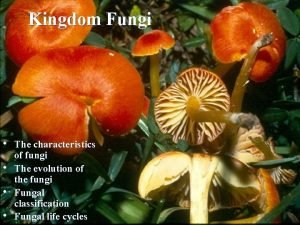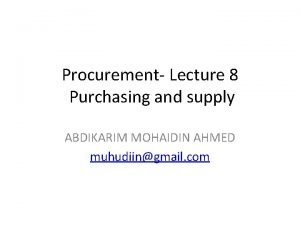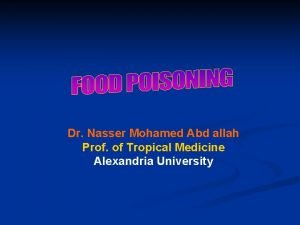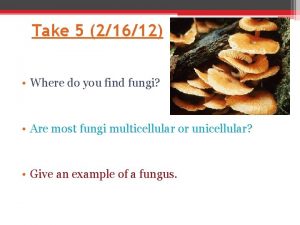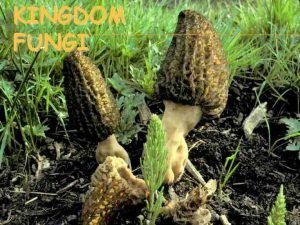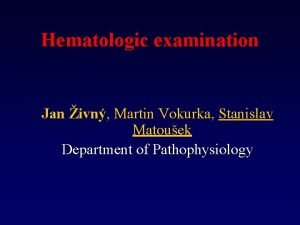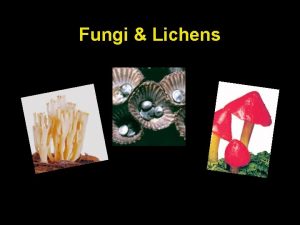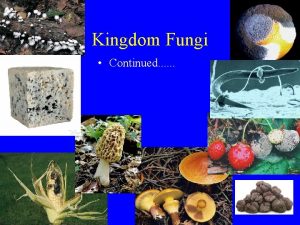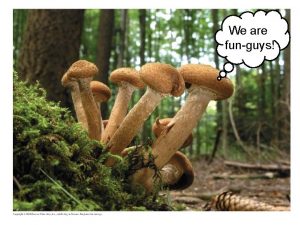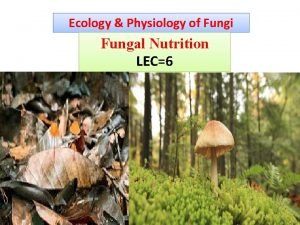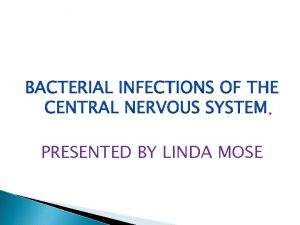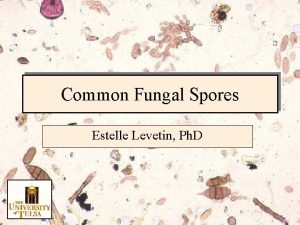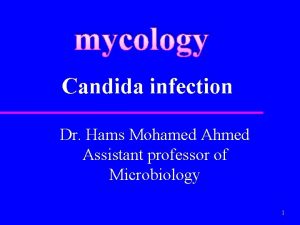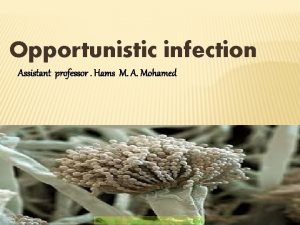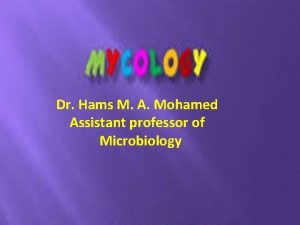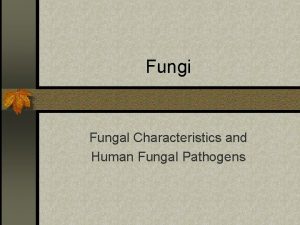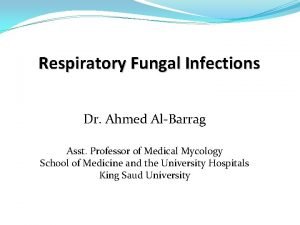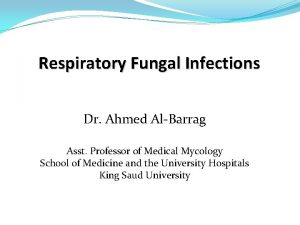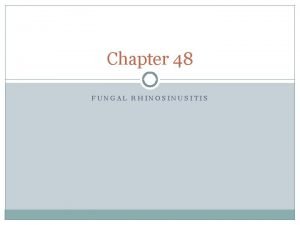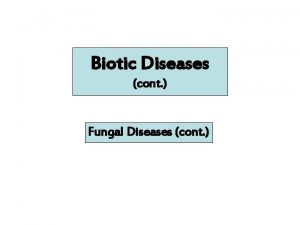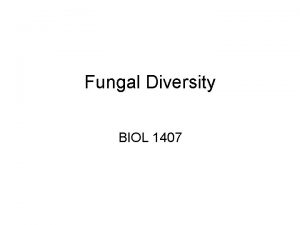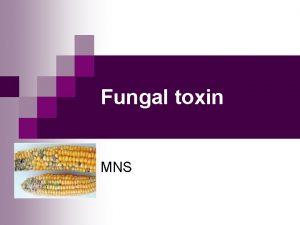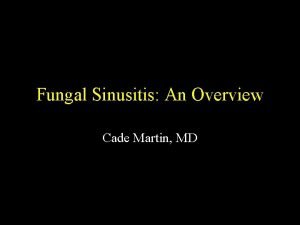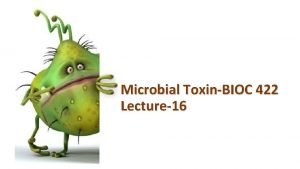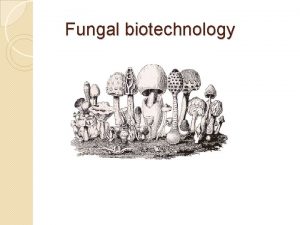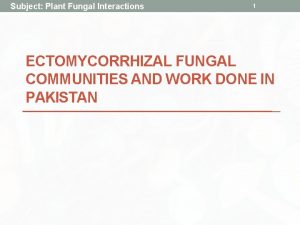FUNGAL SPORES Dr Hams Mohamed Ahmed Assistant professor



























- Slides: 27

FUNGAL SPORES Dr/ Hams Mohamed Ahmed Assistant professor of Microbiology

Reproduction

FUNGAL SPORES Function in reproduction of fungi 1. Sexual reproduction -- Sexual spores 2. Asexual reproduction -- Asexual spores a. Sporulation b. Fragmentation c. Budding 3. Parasexual reproduction -- Genetic exchange

ASEXUAL SPORES 1 -conidia 2. Arthrospore 3. Blastospore 4. Chlamydospore


Blastospore

Aspergillus Species

Rhizopus: sporangium filled with sporangiospores.


SEXUAL SPORES 1. Zygospore 2. Ascospore 3. Basidiospore 4. Oospore

SEXUAL SPORE CLASS Zygospore----- Zygomycetes Basidiospore---- Basidiomycetes Ascospore----- Ascomycetes None/Unknown------ Deuteromycetes (“Fungi imperfecti”)

• Zygospore-----1 -Migration of nuclei will occur in the tips of both progametangia 2 -Septa are laid down at the apex of the progametangia to form isogametangia Zygomycet

3 -Karyogamyimmediately follows to form a multinucleate zygote 4 -The zygote will form a thick, pitted wall around itself to form the zygospore

�Basidiospore---- Basidiomycetes

Ascospore----- Ascomycetes

Stages of ascus formation Ascus mother cell crozie r

PATHOGENICITY OF FUNGI 1. Thermotolerance 2. Ability to survive in tissue environment 3. Ability to withstand host defenses

Features of Fungus Infections o Not contagious; dermatophytes exception o Opportunistic o Host is predisposed and/or exposed to large number of spores o Infections are chronic with granulomatous lesions

o Cell-mediated immunity - important o Hypersensitivity response may develop o Infections are asymptomatic or selflimited


Fungal Infections Clinical Classification Superficial mycoses Subcutaneous/intermediate mycoses Systemic/deep/endemic mycoses Miscellaneous mycoses/yeasts /Opportunistic

Superficial Mycoses Chest, back, upper arm Rarely invade deeper tissue Malssezia

Cutaneous mycosis Skin, hair and nails • Dermatophytes (Microsporum, tricophyton, epidermiphyton)

Subcutaneous Mycoses Madurella v. Confined to subcutaneous tissue and rarely spread systemically. v. The causative agents are soil organisms introduced into the extremities by trauma.

Systemic Mycoses § Caused by: dimorphic fungi § histoplasma, blastomyces, coccidioides, sporothrix § Involve skin and deep viscera § May become widely disseminated § Predilection for specific organs

OPPORTUNISTIC FUNGI saprophytes and occasional pathogens that invade the tissues of those who have: • Predisposing diseases: Diabetes, cancer, leukemia, etc. • Predisposing conditions: Agammaglobulinemia, steroid or antibiotic therapy.

Thank you
 Evolution of fungi
Evolution of fungi Ahmed muhudiin ahmed
Ahmed muhudiin ahmed Professor nasser mohamed
Professor nasser mohamed Ali ahmed is a mathematics professor who tries to involve
Ali ahmed is a mathematics professor who tries to involve Promotion from associate professor to professor
Promotion from associate professor to professor Cuhk salary scale 2020
Cuhk salary scale 2020 Vascular vs nonvascular plants
Vascular vs nonvascular plants Clostridium spores
Clostridium spores What are spores
What are spores Fungi produce _____ spores.
Fungi produce _____ spores. Fungus characteristics
Fungus characteristics Seeds vs spores
Seeds vs spores Remote hams
Remote hams The spores that funguslike protists produce
The spores that funguslike protists produce Basidiomycota characteristics
Basidiomycota characteristics Hams alcohol
Hams alcohol Handiham
Handiham Sferocytosis
Sferocytosis Hams alcohol taper
Hams alcohol taper Milady chapter 10
Milady chapter 10 Fungi and its classification
Fungi and its classification Fungi
Fungi Chapter 10 nail disorders and diseases review questions
Chapter 10 nail disorders and diseases review questions Dictyphora
Dictyphora Basidiocarp life cycle
Basidiocarp life cycle Ocular histoplasmosis
Ocular histoplasmosis Haustorium in fungi
Haustorium in fungi Csf analysis
Csf analysis
